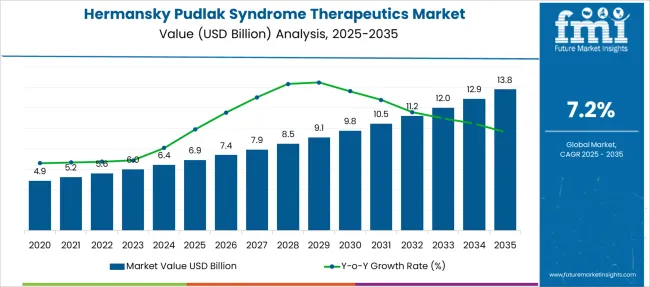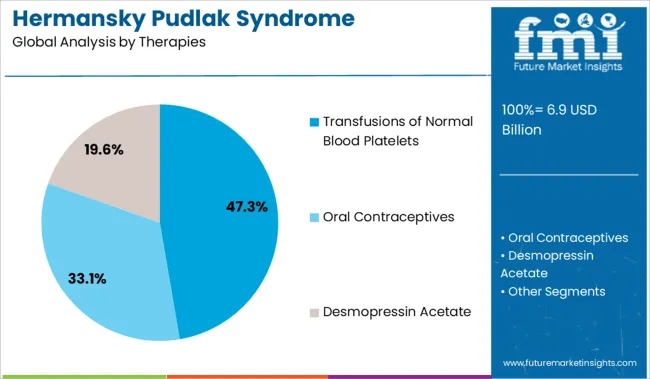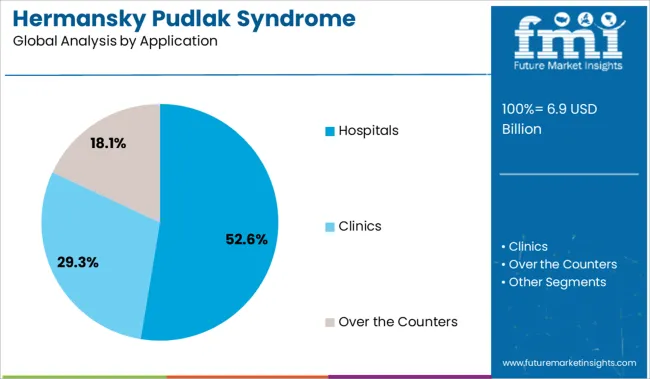The Hermansky Pudlak Syndrome Therapeutics Market is estimated to be valued at USD 6.9 billion in 2025 and is projected to reach USD 13.8 billion by 2035, registering a compound annual growth rate (CAGR) of 7.2% over the forecast period.

| Metric | Value |
|---|---|
| Hermansky Pudlak Syndrome Therapeutics Market Estimated Value in (2025 E) | USD 6.9 billion |
| Hermansky Pudlak Syndrome Therapeutics Market Forecast Value in (2035 F) | USD 13.8 billion |
| Forecast CAGR (2025 to 2035) | 7.2% |
The Hermansky Pudlak Syndrome (HPS) Therapeutics market is evolving steadily, driven by rising clinical awareness and improved diagnostic capabilities for this rare genetic disorder. The current market landscape is marked by a growing emphasis on early intervention and symptom-specific management, as highlighted in rare disease clinical journals and genetic disorder case studies.
Therapeutic demand is being reinforced by increased genetic screening initiatives and collaborations among academic institutions, specialty hospitals, and government-funded rare disease programs. The complexity of HPS, which includes bleeding disorders, pulmonary fibrosis, and albinism, has necessitated a multidisciplinary approach to care, opening pathways for various treatment modalities.
Additionally, as indicated in healthcare investment briefings and medical news updates, there is a growing focus on expanding orphan drug designations and regulatory incentives to drive innovation in this space Advancements in gene therapy research, patient registries, and expanded access programs are further expected to shape future growth, ensuring a more robust therapeutic landscape for HPS globally.
The market is segmented by Therapies and Application and region. By Therapies, the market is divided into Transfusions of Normal Blood Platelets, Oral Contraceptives, and Desmopressin Acetate. In terms of Application, the market is classified into Hospitals, Clinics, and Over the Counters. Regionally, the market is classified into North America, Latin America, Western Europe, Eastern Europe, Balkan & Baltic Countries, Russia & Belarus, Central Asia, East Asia, South Asia & Pacific, and the Middle East & Africa.

The transfusions of normal blood platelets segment is projected to account for 47.3% of the Hermansky Pudlak Syndrome Therapeutics market revenue share in 2025, positioning it as the dominant therapy segment. This leadership is being supported by the critical role platelet transfusions play in managing the bleeding diathesis characteristic of HPS patients. As noted in clinical treatment protocols and institutional reports, platelet transfusion remains the frontline supportive care for preventing and managing excessive bleeding during surgical procedures or trauma.
Hospitals and specialist care centers have consistently administered this therapy due to its immediate effectiveness and relative accessibility. Furthermore, transfusions are often favored due to the absence of targeted pharmaceutical alternatives currently approved for HPS-related bleeding complications.
The stability, safety profile, and availability of donor platelets within hospital settings have reinforced its use as the most reliable therapeutic option These combined factors have maintained its primary position in the treatment spectrum for HPS and are anticipated to continue driving its demand in 2025.

The hospitals segment is estimated to contribute 52.6% of the Hermansky Pudlak Syndrome Therapeutics market revenue share in 2025, establishing itself as the largest application segment. This dominance is attributed to the concentration of expertise, diagnostic infrastructure, and treatment protocols required to manage rare genetic disorders such as HPS. As reported in clinical management guidelines and healthcare institution updates, hospitals serve as primary treatment hubs for administering transfusions, conducting genetic counseling, and managing associated complications like pulmonary fibrosis and granulomatous colitis.
The complexity of HPS care, often requiring coordinated efforts across hematology, pulmonology, dermatology, and ophthalmology, has centralized its treatment in hospital environments. Moreover, the presence of multidisciplinary teams and access to emergency care during acute bleeding episodes have further reinforced the preference for hospital-based treatment.
Institutional research programs and rare disease networks are also typically anchored within hospitals, ensuring continuous access to evolving therapeutic interventions These factors collectively support the segment's dominant role in delivering comprehensive care for HPS patients.
The global demand for hermansky pudlak syndrome Therapeutics is projected to increase at a CAGR of 7.2% during the forecast period between 2025 and 2035, reaching a total of USD 13.8 Billion in 2035, according to a report from Future Market Insights (FMI). From 2020 to 2025, sales witnessed significant growth, registering a CAGR of 6%.
The increased frequency of hermansky pudlak syndrome among the general population, as well as the growing elderly population, which is more vulnerable to certain medical diseases, is among the primary drivers driving the global market. Additionally, the increasing acceptance of health insurance policies that give financial support for hermansky pudlak syndrome Therapeutics and lower healthcare costs is favorably affecting the market.
Furthermore, various countries' governments are raising awareness regarding blood and plasma donation. They are also promoting blood donation camps through various programs.
Aside from that, rising knowledge regarding the availability of viable Therapeutics options is boosting the market's prospects. Hence, the Research and Development initiatives and significant advances in healthcare infrastructure and diagnostic technologies are projected to create a positive outlook for the industry.
Increasing Prevalence of Blood Coagulation Disorders to Improve Maintenance and Performance
Hermansky-Pudlak syndrome is a rare hereditary disorder that produces unusually pale skin, hair, and eye pigmentation (oculocutaneous albinism). People with the syndrome are more likely to develop blood issues, and lung, and digestive problems, and are more vulnerable to UV damage.
The majority of bleeding problems are inherited, although some are acquired as a result of liver illness, pharmaceutical side effects, low red blood cell count, vitamin K insufficiency, and other factors. Due to an increase in the number of individuals suffering from liver illnesses, anemia, and other blood coagulation disorders, the bleeding disorders Therapeutics market is predicted to rise rapidly over the forecast period.
Positive Government Initiatives in Developed Countries to Fuel Market Growth
The hermansky-pudlak syndrome therapeutics market is expanding due to an increase in the number of patients diagnosed with bleeding disorders, increased research and development activities and investments by key players, increased awareness about bleeding disorders, and positive government initiatives in developed countries aimed at establishing a large network of diagnosis and Therapeutics centers, which are complementing market growth.
A Dearth of Qualified Professionals is expected to be a Major Impediment to Market Growth
The scarcity of skilled specialists and talented professionals would be a key impediment to the market's growth for bleeding disorders testing. Medication pricing will also limit the market growth.
Inadequate reimbursement rules will also restrict the breadth. Unprofessional therapy can have major health effects on patients. This challenge is stifling market growth.
Low Regulatory Compliance will stifle Market Growth
The failure of national organizations and other institutions in poor countries to raise awareness about certain ailments resulted in low testing penetration. This issue stifles market growth by hindering early diagnosis and appropriate patient care.

Government Initiative to Improve Healthcare Infrastructure Expands Profit Margins
The Asia Pacific area is expected to increase rapidly over the projected period of 2025 to 2035. As a result of increased awareness of bleeding disorders and Therapeutics options, Asia-Pacific is expected to grow at a rapid pace in the coming years, increasing the global hermansky-pudlak syndrome Therapeutics market.
Furthermore, the market share in the Asia-Pacific region is expected to expand in the near future as a result of improved access to Therapeutics facilities and the rising need for increased government efforts, sophisticated technology, higher adoption rates, and rising healthcare spending. As per Future Market Insights, the Asia Pacific is expected to grow at a CAGR of 6.9% in the assessment period 2025 to 2035.
Better Healthcare Facilities to Accelerate Market Growth
Due to its cost-effectiveness and access to healthcare facilities, North America is likely to lead the global hermansky-pudlak syndrome Therapeutics market. Patient awareness of bleeding disorders, as well as private-sector and government Therapeutics initiatives, is assisting in market development.
Because of the preliminary stage acceptance of proven medical technology, the market in the area is the rapid ongoing expansion of firms operating in the drug sector. Because of the growing incidence of various blood illnesses and increased patient awareness in this field, North America is expected to have a considerable market position in the market. North America is expected to grow at a CAGR of 7.1% in the assessment period 2025 to 2035.
Technological Advancement fuelling the Market Growth
Europe is predicted to have the second-greatest market share. Factors such as an increase in research costs, technological advancement, deteriorating human health, and the need for novel and effective medicines drive the expansion of the market in this area. Thus, owing to the aforementioned reasons, Europe is expected to grow at a CAGR of 7% in the assessment period 2025 to 2035.
The Hospital Segment to enhance Sales Prospects
During the evaluation period, the hospital segment is predicted to be the quickest category. This is due to the high hospitalization rate of SMA. Because of the significant risk and scoliosis, the majority of clients are treated in hospitals. According to the Orphanet Journal of Rare Diseases (2024), children patients aged 0 to 4 years had the greatest inpatient ratio.
Key start-up players in the automotive axles are offering new and innovative product lines to consolidate their market presence, these aforementioned start-ups have left no stone unturned. Some specific instances of key Hermansky Pudlak Syndrome Therapeutics start-ups are as follows:

Leading hermansky pudlak syndrome Therapeutics companies are concentrating on strategic initiatives such as partnership development, acquisitions, mergers, and others. These steps are being taken to improve the market position.
Recent Developments:
| Report Attribute | Details |
|---|---|
| Market Value in 2025 | USD 6.9 billion |
| Market Value in 2035 | USD 13.8 billion |
| Growth Rate | CAGR of 7.2% from 2025 to 2035 |
| Base Year for Estimation | 2025 |
| Historical Data | 2020 to 2025 |
| Forecast Period | 2025 to 2035 |
| Quantitative Units | Revenue in US Billion and CAGR from 2025 to 2035 |
| Report Coverage | Revenue Forecast, Company Ranking, Competitive Landscape, Growth Factors, Trends, and Pricing Analysis |
| Segments Covered | Therapies, Application, Region |
| Regions Covered | North America; Latin America; Europe; Asia Pacific; Middle East and Africa (MEA) |
| Key Countries Profiled |
The US, Canada, Brazil, Mexico, Germany, The UK, France, Spain, Italy, China, Japan, South Korea, Singapore, Thailand, Indonesia, Australia, New Zealand, GCC, South Africa, Israel |
| Key Companies Profiled | American Regent; Dr. Reddy's; Gland Pharma Limited; Sagent Pharma; Sun Pharma; Teva Pharmaceuticals; Ferring Pharmaceuticals; UbiPharm; Allergan PLC; Glenmark Pharmaceuticals |
| Customization | Available Upon Request |
The global hermansky pudlak syndrome therapeutics market is estimated to be valued at USD 6.9 billion in 2025.
The market size for the hermansky pudlak syndrome therapeutics market is projected to reach USD 13.8 billion by 2035.
The hermansky pudlak syndrome therapeutics market is expected to grow at a 7.2% CAGR between 2025 and 2035.
The key product types in hermansky pudlak syndrome therapeutics market are transfusions of normal blood platelets, oral contraceptives and desmopressin acetate.
In terms of application, hospitals segment to command 52.6% share in the hermansky pudlak syndrome therapeutics market in 2025.






Full Research Suite comprises of:
Market outlook & trends analysis
Interviews & case studies
Strategic recommendations
Vendor profiles & capabilities analysis
5-year forecasts
8 regions and 60+ country-level data splits
Market segment data splits
12 months of continuous data updates
DELIVERED AS:
PDF EXCEL ONLINE
Biotherapeutics Virus Removal Filters Market Trends – Growth & Forecast 2025 to 2035
COPD Therapeutics Market Report – Growth, Demand & Industry Forecast 2023-2033
Digital Therapeutics and Wellness Market Size and Share Forecast Outlook 2025 to 2035
Digital Therapeutics Market Size and Share Forecast Outlook 2025 to 2035
Peptide Therapeutics Market Analysis - Growth & Forecast 2024 to 2034
Advanced Therapeutics Pharmaceutical Outsourcing Market Size and Share Forecast Outlook 2025 to 2035
Glaucoma Therapeutics Market Size and Share Forecast Outlook 2025 to 2035
Leukemia Therapeutics Treatment Market Analysis - Growth & Forecast 2025 to 2035
Microbiome Therapeutics Market Size and Share Forecast Outlook 2025 to 2035
The Canine Flu Therapeutics Market is segmented by product, and end user from 2025 to 2035
Stuttering Therapeutics Market Trends, Analysis & Forecast by Treatment, Type, End-Use and Region through 2035
Pet Cancer Therapeutics Market Insights - Growth & Forecast 2024 to 2034
Candidiasis Therapeutics Market Size and Share Forecast Outlook 2025 to 2035
Lung Cancer Therapeutics Market Analysis – Size, Share, and Forecast Outlook 2025 to 2035
Heart Block Therapeutics Market Size and Share Forecast Outlook 2025 to 2035
Aquaculture Therapeutics Market Size and Share Forecast Outlook 2025 to 2035
Fucosidosis Therapeutics Market - Growth & Innovations 2025 to 2035
Market Leaders & Share in Alzheimer’s Therapeutics
Alzheimer’s Therapeutics Market Analysis by Disease Class into Cholinesterase Inhibitors, NMDA Receptor Antagonists and Combinations Through 2035.
Sarcoidosis Therapeutics Market

Thank you!
You will receive an email from our Business Development Manager. Please be sure to check your SPAM/JUNK folder too.
Chat With
MaRIA